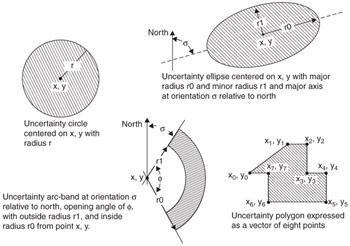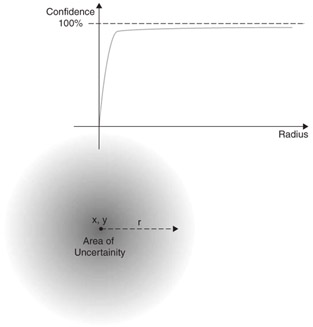Uncertainty and Confidence in Location Determination
Uncertainty and confidence are two important concepts associated with any measured location. The terms are in widespread use in both technical specifications and regulatory documents but they are often misunderstood.
It may be readily understood that any technique, however sophisticated, that's used to determine a location will be subject to some degree of error. While a geodetic location is most obviously thought of as a specific point on the surface of the geoid-that is, a latitude and longitude expressed to the necessary degree of precision to exactly identify the point-it should be noted that a measured location will actually cover an area on the surface of the geoid. In other words, the target of the location measurement is not known to be at a particular point but is only said to be somewhere within that area. This is known as an area of uncertainty. The shape of this area of uncertainty may vary. The method of location determination may represent its result as a simple circle centered on a specific point, or it may utilize strict bounding rules that allow it to represent the result as a polygon (see Figure 1.7).

Figure 1.7: Uncertainty expressed as different shapes.
In practice, it must be assumed that the target is equally likely to be at any location within that area of uncertainty-despite the tendency of many to presuppose that the center is the more likely location, especially if the uncertainty area is provided as a circle. In reality, there may be a greater or lesser likelihood that the target is at one point rather than another within that area of uncertainty, but the form of presentation, as a simple area, has no way to convey that information, so all points must be assumed to be of equal likelihood.
The question of "likelihood" is pertinent to how big an area of uncertainty is provided as part of a location. The answer depends not only on the accuracy of the measurement technology used to determine the location, but it also depends on what "confidence" should be associated with the result. Typically a location measurement technology will not provide hard edges associated with uncertainty. That is, it is not generally possible to say that the target is definitely within a particular area and definitely not outside that area of uncertainty. The likelihood of the target being within the area of uncertainty is known as the "confidence" of the result. In fact, confidence will usually vary in quite complex ways across the possible area within which the target may lie. Figure 1.8 shows the situation where confidence only approaches 100 percent asymptotically with distance from a determined point. So, for this situation, an area of uncertainty representing 100-percent confidence that the target is located within it would actually be a circle of infinite radius. This is hardly a useful representation of the location since it effectively says that the target is somewhere, but it could be anywhere.

Figure 1.8: Non-linear location/confidence relationship.
Note that, in theory, the probability of a location point being the correct one can vary from one point to the next in a complex way that is governed by the environment, and the characteristics of the measurement technology brought to bear to determine the location. In other words, it is possible to define the location of a target as a locus of points in two- or three-dimensional space, with each point representing a possible location of the target and where each point has its own probability that this is the actual location. For most applications, and particularly where a human is the consumer of the location representation, this is not a practical form of representation. Thus, the form is usually simplified to a simple circle or other shape representing an area of uncertainty. The confidence that this area really does capture the correct location is the aggregate (or integral) of all the individual probability values for each of the points in that area. This creates the situation where confidence information internal to the area is lost and all points should be assumed to be equally likely. To properly understand the significance of the area of uncertainty, the confidence level associated with that area should also be known. That is, if all points inside the area must be considered equally likely, it would be good to at least know what the likelihood is that the real location may be outside this area. Going back to the previous figure and noting that a circle of uncertainty with infinite radius isn't particularly useful, an arbitrary degree of confidence may be taken (see Figure 1.9).

Figure 1.9: Obtaining an area of uncertainty at a specific confidence level.
For example, if we want to know the location of the user at the 67th percentile of confidence, the radius of the area of uncertainty can be expressed as the finite value of r1 meters. In practice, this means that the application may assume that the target is within r1 meters of the provided location but it will be correct only two times out of every three measurements. Thus, one in three times the actual location will be somewhere outside of the uncertainty, and will be more than r1 meters away by an unknown amount.
If one in three times is too frequent for the application to have no information about the location of the target, then a higher level of confidence in the result is required. Going back to the figure, we can identify the uncertainty at which confidence is at 95 percent. This means that the area of uncertainty is now bigger at r2 meters. While the area of uncertainty is now greater, the application can be confident that the location provided will be correct, in the sense that the target really is contained within the provided area of uncertainty, 19 times out of 20. This is a considerable improvement on two out of three. Of course, the optimal combination of uncertainty and confidence will be very application-specific. Many applications may not even care about uncertainty, let alone confidence, and will simply use the center of the uncertainty in all cases. The most sophisticated applications, however, will utilize not just the uncertainty information but will have the functionality to handle the boundary circumstance of the actual location being outside the area of uncertainty.
Returning again to emergency services, this is an example of an application that will care about both uncertainty and confidence. For a geodetic form of location, the uncertainty is generally represented as a circle around a point. This can be displayed on the operator's screen as that circle overlaid on the street map information. This can be used to provide guidance to the dispatched services in terms of where they should search for the subject of the call. Procedures must also exist, however, that acknowledge that the subject may even be outside of this area, since it is only provided at a specific level of confidence, and these contingency procedures are just as important a part of the application as directing services within the area of uncertainty. The exact nature of such contingency procedures will depend on the frequency with which the actual location lies outside the area of uncertainty, and the frequency of these occurrences will depend on the confidence level where the area of uncertainty was generated.
In terms of U.S. emergency services, the FCC actually prescribed the specification for cellular location uncertainty to be two levels of confidence. For example, handset-based solutions such as GPS had to be accurate to within 50 meters, 67 percent of the time and to within 100 meters, 95 percent of the time. In the terms we have just been discussing, this can be represented by two concentric circles, one being an area of uncertainty with a radius of 50 meters and 67 percent confidence and the other being an area of uncertainty with a radius of 100 meters and a confidence of 95 percent, as shown in Figure 1.10. Network-based solutions, which would work with legacy handsets, were constrained to a looser accuracy requirement-150 meters at 67-percent confidence and 300 meters at 95-percent confidence.

Figure 1.10: FCC-prescribed cellular uncertainty and confidence.
EAN: 2147483647
Pages: 129